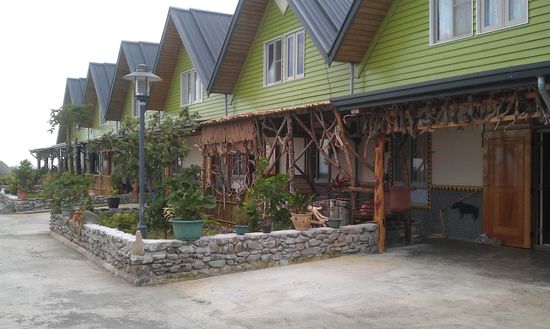


Indigenous Links to the Land: Morakot Totem Stories Adorn Houses

In order to create permanent housing bases that are in line with the indigenous cultural background, the Executive Yuan’s Reconstruction Council coordinated efforts with the Council of Indigenous People of the Executive Yuan to subsidize efforts for residents to beautify the exteriors of their houses to connect them emotionally to the indigenous land. As of now, approximately 710 households have submitted applications and gradually completed construction on permanent housing bases such as Rinari Community of Pingtung County, Yuemei Da Ai Community in Kaohsiung City and so on. The creativity of indigenous residents can be seen everywhere, exhibiting the emotional link between the new villages and the homeland. If you pass through the reconstruction areas, be sure to stop and appreciate these projects, as you will surely come away with some new realizations.
Typhoon Morakot caused landslides that submerged or threatened most indigenous housing in southern Taiwan, which is why the government worked with NGOs to construct permanent houses for disaster victims. However, as the permanent houses could not be constructed in accordance with the cultural features of each specific tribe, the Reconstruction Council especially amended the software and hardware project of cultural reconstruction and added an execution strategy for “architectural language and creation of a cultural environment”. Homeland reconstruction such as the appearance of villages, cultural sights, and architectural ethics are executed through “independent village planning” and “tribe people completing tribe construction” in efforts to reconstruct the cultural environment in permanent housing bases. The main policy goals are proving the existence of intangible cultural value through tangible architectural means and reviving traditional tribal crafting techniques and social solidarity. In addition to adding cultural variation and diversity to permanent housing bases, this also records of the tribe’s migration history .
Households are encouraged to completed their own construction projects, or exchange labor with others within the tribe, which indirectly increases the amount of work opportunities available within the reconstruction area. It seems as if many of the indigenous residents are natural artists able to recreate the beautiful scenery of their past homeland entirely through painting at their new residences. Just as Chairman Chen Zai-huei of the Haocha Village reconstruction committee said, these scenes of homeland were mainly painted because elders missed the sight of their homeland very much. This way, elders would not have to travel a great distance back and be able to assuage their homesickness by seeing the same landscapes at their new homes. Some residents also used various decorative elements such as driftwood, stone slate from their previous homes, bamboo cut from mountains around their homes, and even betelnut tree trunks. The clever use and arrangement of these elements have given the houses new looks and instilled deep cultural significance into the new villages.
As the completion dates for different permanent housing bases are also different, the project is being implemented in two stages. The first stage of the project should complete work for 710 households at 6 permanent housing bases: Pingtung County’s Rinari, Changzhi Baihe, and Kajajanan community, Kaohsiung City’s Yuemei Da Ai Community, Taitung County’s Kaaluwan second base, ex-Dawu Primary School permanent housing base by November 30th this year. Construction and inspection has gradually been completed for all the households now, that is to say, 710 indigenous households living on the permanent housing bases have already benefitted from this project. Acceptance of applications for the second stage of the project also began on September 1st this year, with a cutoff date of December 30th. Indigenous households living on the various permanent housing bases can submit their application at the township office in their district. Once the application process is complete, construction may begin. The projected completion date is June 30th, 2012. 17 bases are included in the plans for the second stage of this project, to benefit roughly 1,015 indigenous households on permanent housing bases.
Pingtung County Changzhi Baihe Permanent Housing Base– Current Execution of the Architectural language Project

Pingtung County Rinari Permanent Housing Base – Current Execution of the Architectural language Project

Taitung County ex-Dawu Primary School Permanent Housing Base– Current Execution of the Architectural language Project






